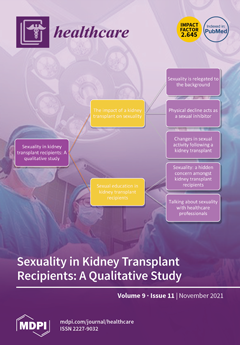Open AccessArticle
Social Support, Self-Care Behaviour and Self-Efficacy in Patients with Type 2 Diabetes during the COVID-19 Pandemic: A Cross-Sectional Study
by
Premalatha Paulsamy, Rizwan Ashraf, Shadia Hamoud Alshahrani, Kalaiselvi Periannan, Absar Ahmed Qureshi, Krishnaraju Venkatesan, Vani Manoharan, Natarajan Govindasamy, Kousalya Prabahar, Tamilselvi Arumugam, Kumar Venkatesan, Kumarappan Chidambaram, Geetha Kandasamy, Rajalakshimi Vasudevan and Kalpana Krishnaraju
Cited by 7 | Viewed by 3235
Abstract
Diabetes mellitus is a major public health issue that considerably impacts mortality, morbidity, and healthcare costs worldwide. The COVID-19 pandemic has created havoc in diabetes management, too, like other spectrums of life. A descriptive, cross-sectional study was adopted to determine the effect of
[...] Read more.
Diabetes mellitus is a major public health issue that considerably impacts mortality, morbidity, and healthcare costs worldwide. The COVID-19 pandemic has created havoc in diabetes management, too, like other spectrums of life. A descriptive, cross-sectional study was adopted to determine the effect of Social Support, Self-Care Behaviour and Self-Efficacy in Type 2 Diabetes Mellitus (T2D) during this COVID-19 pandemic. Two hundred T2D patients who satisfied the inclusion criteria were chosen using a convenient sampling procedure. The tool consists of four sections, including socio-demographic characteristics, Multidimensional Scale of Perceived Social Support (MSPSS), revised Summary of Diabetes Self-Care Activities (SDSCA) Scale and modified Diabetes Management Self-Efficacy Scale (DMS). Descriptive and inferential statistics were used to analyze the obtained data. The mean and SD of diabetic management self-efficacy is 5.74 (1.95) and 4.37 (1.4), respectively, for patients with HbA1c < 6.5% and HbA1c ≥ 6.5%. The self-care activities of the patients who had good glycemic control were 4.31 (2.06) compared to 3.50 (1.73) who did not. The social support received by the patients was 6.13 (2.13) vs. 5.31 (1.67) among patients with glycemic control vs. no control. The results show that social support (
p = 0.04), self-efficacy (
p =0.01) and self-care activities (
p = 0.001) were significantly related to the level of glycemic control of the T2D patients. A significant relationship was also identified between gender (
p = 0.036), age (
p = 0.001) and education status (
p = 0.000) with HbA1c control of the participants. This study demonstrates a significant relationship between social support, self-care behaviours, self-efficacy and glycemic management in T2D patients. During this COVID-19 pandemic, interventions to enhance the self-care activities like exercise and social support to boost their self-efficacy; for better diabetes management, reducing diabetes complications or prolonging their onset are the need of the hour.
Full article
►▼
Show Figures






